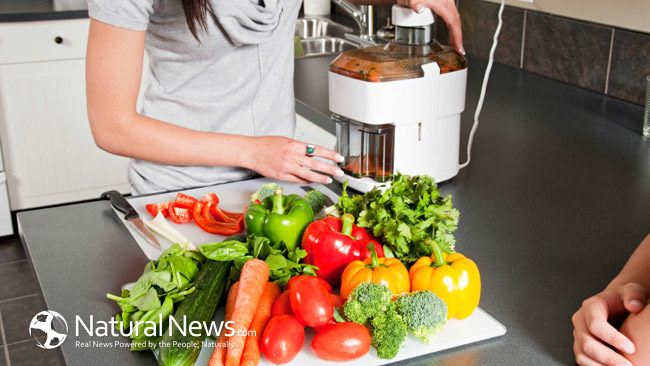Juicing for health offers a wealth of benefits for the body, including the removal of toxins from the internal cell walls, improving energy, reducing the symptoms of depression, ridding arthritic pain, cleansing the liver, and helping the skin look clear and healthy.
Juicing for health is beneficial for the body because it gives the digestive system sufficient time to rest. A lot of our energy goes toward digesting food. The colon is fully cleansed of undigested matter, helped by the flood of phytonutrients from fruits and vegetables. Some individuals enjoy a 1 day fast once a month, while other people like to juice fast for up to 30-days. Consult your doctor before you start the fast. If you have type II diabetes, limit your intake of fruit juices and drink more vegetable juices. The juice fast benefits that you may notice include a greater mental clarity, lower levels of anxiety, weight loss, and glowing skin, to name just a few.
Fruit and vegetable juices are tasty, nutritious, and wholesome. Advocates of fasting state it is perfectly okay to go on a longer juice fast of 60 to 90-days, but it is important that you are medically supervised for safety. If you are new to juice fasting, aim for 1 to 3 days before you explore an extended fast.
The Benefits of Pulp
A juicer strips the fibrous coating off the fruit or vegetable, delivering a freshly coloured juice. Without the fibrous content, the body is given a rest from digestion. However, the wholesome fiber is separated from the juice and does not have to go to waste. Many people throw away the pulp after juicing, but it is worthwhile to add this fiber rich content to recipes. Fiber is necessary for the health of the colon.
During my juice fast, I simmered vegetable pulp in water for an hour, removed the pulp, and drank it as broth. Vegetable pulp is ideal to use in vegetable patties, stocks, soups, and casseroles, while fruit pulp can be used to make sorbets, muffins, and flapjacks.
The Juicing Basics
Invest in a good juicer. There are two types available—centrifugal and masticating. A centrifugal juicer blade works at very high speeds and allows larger pieces of fruits and vegetables to be juiced completely, while a masticating juicer gently chews the fruits and vegetables, but requires a lot of chopping and preparation before use. From my experience, I have used both centrifugal and masticating juicers, each with their advantages and disadvantages.
There is a manual masticating juicer that is both affordable and easy to clean. It is securely fixed to a kitchen worktop. I tried to juice beets once and it resulted in a beet-stained kitchen. However, this item is great for wheatgrass.
After juicing, drink the froth. Rather than drink it as a regular fruit or vegetable juice, Jason Vale, Juice Master, recommends that we swish it in our mouth for a few seconds, which effectively ‘chews’ the vegetables. Consider how long it will take to drink a juice of five carrots, while it would take far more time to eat the same amount of carrots whole.
Advantages and Disadvantages of a Centrifugal Juicer
- Positive: They are affordable.
- Positive: Whole fruits and vegetables can be juiced.
- Positive: Easy to clean.
- Positive: Pulp collects in a separate container.
- Negative: Vegetables can become blocked during juicing.
- Negative: Very noisy and can shake during use.
- Negative: Not great for fresh apple juice.
- Negative: The machine may not last long.
Positives and Negatives of a Masticating Juicer
- Positive: Delivers pure, fresh fruit and vegetable juices. The juice will taste fresh even when drank hours later.
- Positive: Quiet yet powerful.
- Positive: Some masticating juicers have a 10-year guarantee.
- Positive: Juices leafy vegetables and wheatgrass.
- Positive: Can also be used to make sorbets, pasta, and baby food.
- Positive: Easy to clean.
- Negative: Expensive juicing machine.
- Negative: A lot of preparation is required to chop the fruits and vegetables into small pieces, to allow them to fit into the small chute.
- Negative: Can be time consuming to juice.
Vegetable Pulp Patties
There is a lot of nutritious goodness contained in the skin of vegetables. They contain fiber, essential to maintain the health of the colon. This recipe requires a dehydrator, which pulls moisture out of fresh food.
- ¼ cup of oats
- ¼ cup of flax seeds
- Pinch of oregano
- Sprinkling of salt and pepper
- A tbsp or two of virgin olive oil
Mix the vegetable pulp with the other ingredients. Add to a dehydratorand remove when a crispy layer has formed on the outside of the pattie (around 7 hours). Serve with salad, or on a couple of slices of fresh rye bread.
Vegetable Soup Stock
In order to make this soup stock, save up a week’s worth of vegetable pulp. Freeze each batch after use
- Vegetable pulp
- Bay leaf and/or other choice of herbs
Add the pulp to a large pan. Cover with cold water, bring to the boil, and simmer for an hour. Use the stock for any soup or casserole recipe.
In Conclusion
Juicing for health is an excellent way to improve the immune system and prevent illness and disease. Juicing produces both a healthy nutritious juice, while the fibrous content is collected in a separate container. This can be thrown away or used in recipes like vegetable patties, soup stock, and muffins or bread. It is also important to invest in the right juicer, as there are two types—centrifugal or masticating. Both have advantages and disadvantages.
Sources
Juicing for Health – How Long Should You Juice Fast?
Go Raw – Vegetable Pulp Patties
The Best Juice Reviews – Juicer Pulp Recipes: Vegetable Soup Stock





